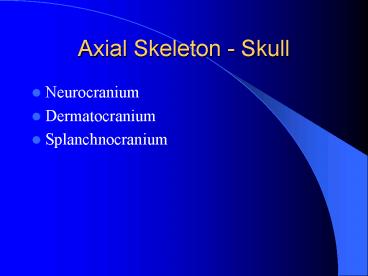Axial Skeleton Skull - PowerPoint PPT Presentation
1 / 36
Title: Axial Skeleton Skull
1
Axial Skeleton - Skull
- Neurocranium
- Dermatocranium
- Splanchnocranium
2
Dermatocranium
- Phylogeny membrane bone which evolved from
dermal armor - Roofing bones
- Along side and above brain
3
Roofing Bones
- Nasal
- Frontal
- Parietal
- Orbital
- Lacrimal
- Jugal Infraorbital Zygomatic
- Squamosal
4
(No Transcript)
5
(No Transcript)
6
(No Transcript)
7
- Look at the Skull Lower Jaw components page.
Examine the roofing bones.
8
Upper jaw
- Premaxilla
- Maxilla
9
(No Transcript)
10
(No Transcript)
11
Lower Jaw
- Dentary - largest
- Splenial small, dorsomedial
- Surangular - lateral
- Angular medial, becomes typanic bulla
- Coronoid medial
- Prearticular medial caudal becomes anterior
malleus in mammals
12
(No Transcript)
13
(No Transcript)
14
(No Transcript)
15
Key Points
- Look at upper and lower jaw dermatocranium bones
on Skull Lower Jaw Components page - Give an example of homology.
- What trend do you see in lower jaw evolution?
16
Primary Palate Bones
- Roof of oropharyngeal cavity in fish, amphibians
- Roof of nasal cavity in amniotes
17
(No Transcript)
18
Primary Palate
- Vomer
- Palatine
- Pterygoid
19
(No Transcript)
20
(No Transcript)
21
Primary Palate
- Examine Skull Lower Jaw Components page
22
Dermatocranium
- Operculum
23
Key Point
- Describe dermatocranium bones in the shark
24
Axial Skeleton - Skull
- Neurocranium
- Dermatocranium
- Splanchnocranium Visceral skeleton
25
Splanchnocranium
- Supports allows movement of jaws, gill, tongue
- Associated with hearing
- Ancient in evolution
- Replacement bone
26
Splanchnocranium
- Typically 6 gill slits between
- Visceral arches
- A typical visceral arch that is gill in function
has five segments - Pharyngobranchial
- Epibranchial
- Ceratobranchial
- Hypobranchial
- Basibranchial
27
(No Transcript)
28
(No Transcript)
29
Splanchnocranium
- Mandibular arch Visceral Arch I
- Palatoquadrate
- Mandibular Meckels Cartilage
30
(No Transcript)
31
(No Transcript)
32
Splanchnocranium
- Hyoid arch Visceral arch II
- Hyomandibula
- Ceratohyal
- Basihyal
33
(No Transcript)
34
Interrelationships
- The neurocranium, dermatocranium and
splanchnocranium eventually becomes intimately
associated to form one single, firm skull
35
Key Point Describe the origin of jaws from this
picture
36
Key Point
- The three main components of the cranium are































